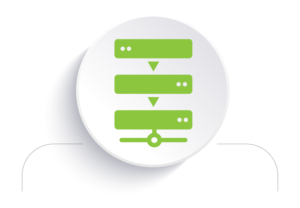A modern company needs an efficient and secure computer network. Structured cabling, WiFi networks, and separate VLANs are the basis for the functioning of computer networks today. A well-built computer network means freedom to connect new devices while maintaining high network security. In the computer networks we install, we use high-quality assembly systems that ensure stable operation and allow for easier expansion of the network in the future and comfort of its use. We approach each installation very individually, taking into account the customer's capabilities and needs when designing and building the network.

Computer Networks

Construction of computer networks
Building computer networks is a process that requires planning, design, installation and configuration of network hardware and software. A computer network consists of many components such as computers, switches, routers, cables, access points, servers and firewalls. Each of these elements plays a specific role in ensuring communication and data exchange between devices on the network.
To build a computer network, you must first define its purpose, scope and requirements. Then select the appropriate network type, e.g. local (LAN), wide area (WAN) or wireless (WLAN). You also need to decide on the network topology, i.e. how network elements are connected. The most common topologies are star, ring, bus and mesh.

WiFi networks
Nowadays, it is almost impossible to function without a WiFi network. We need a wireless network for business meetings, scanning products in warehouses, making phone calls, in a company, in a hotel, at home. More and more devices need an Internet connection via WiFi. In smart homes, WiFi is basically necessary to turn on the lighting in a room or in the garden. The availability of WiFi is one of the basic criteria used by hotel guests when choosing a place to stay. For this reason, we help and advise our clients in the selection of devices, and we design and build professional WiFi networks tailored to the client's needs. Learn more about WiFi networks.

Network devices
The selection of appropriate network devices is very important because they should be compatible with each other and meet the functional and performance requirements of the network. Network devices enable communication and data transfer between computers and other devices connected to the network. Network devices perform different functions depending on their type and method of use. Some of the most popular network devices are:
- Router – a device that connects various networks and directs the traffic of data packets, determining the appropriate route for them.
- Server – a device that stores and shares resources on the network, such as files, printers, databases or applications.
- Switch – a device that connects various devices in one network and transmits data only to the appropriate recipient, using MAC addresses.

Network software
It enables communication and cooperation between computers connected to the network. Network software can be installed on a server or workstations and can perform various functions, such as:
- file sharing.
- printer sharing.
- sharing resources and applications.
- sharing data or services.
Networking software can also monitor network health and performance and ensure security and threat protection. Networking software can be based on various Internet protocols, such as TCP/IP, and can run under various operating systems, such as Windows, Linux, Unix, or NetWare.

Computer network configuration
It is the process of setting network parameters such as IP addresses, subnet masks, default gateways, and DNS servers to enable communication between devices connected to the network. Network configuration can be performed manually by the network administrator or automatically by networking software. Network configuration is an important aspect of network management because it affects network performance, security, and reliability.
After completing the installation and configuration of the network, it should be tested and checked for correctness. Testing involves checking whether all network elements are working properly and whether there are any errors or conflicts. Checking involves monitoring network parameters such as throughput, latency, packet loss and signal quality.

Trust the experience
Building computer networks is a complex and difficult task that requires technical knowledge and practical skills. That is why we meet the expectations of our customers and provide professional installation services.

Computer network audit
A thorough analysis of the technical and functional condition of your network, detection and removal of problems, assessment of risk and compliance with norms and standards.

Computer network design
Development of an individual network design tailored to the needs and requirements of your company, taking into account the latest technologies and solutions.

Installation of a computer network
Professional installation and configuration of network hardware and software, testing and commissioning of networks, ensuring full functionality and stability.

Computer network maintenance
Constant supervision and monitoring of network operation, prevention of failures and disruptions, quick response to reports and failures, updating and modernization of the system.

Computer networks Krakow
Computer networks are an indispensable element of every modern company. They ensure fast and secure communication, data exchange and access to Internet resources. However, for a computer network to fulfill its tasks, it must be properly designed, installed and configured. And this requires the knowledge and experience of specialists.
Teleaudyt offers comprehensive computer network services for small and medium-sized enterprises. Our team consists of qualified specialists who have industry certificates and up-to-date knowledge of the latest technologies.
We offer:
- Design and construction of LAN, WAN, WLAN, VPN computer networks
- Installation and configuration of network equipment (routers, switches, access points, firewall)
- Administration and monitoring of computer networks
- Diagnostics and removal of network failures
- Audit and optimization of existing computer networks
- Consulting and training in the field of computer networks
Our goal is to provide customers with reliable, efficient and secure computer networks that will support their business activities. That's why we care about the quality of our services, timely execution of orders and flexibility in adapting to individual customer needs.
If you are looking for a professional computer networking company, contact us . We will be happy to answer your questions, present an offer and arrange a visit to your company. Don't delay, call or write to us today!
What elements does a computer network consist of?
A computer network consists of several basic elements:
- Hosts: These are network computers that allow users to access the network.
- Servers: These are always-on computers with high computing power, which are equipped with capacious and efficient RAM and mass storage.
- Transmission medium: This is an information carrier that performs the function of a communication channel, e.g. copper cables, optical fibers, telephone lines, radio or satellite links.
- Network equipment: This group includes hubs, switches, routers, network cards, modems and access points.
- Software: Contains operating systems and applications that manage network resources and enable communication between devices.
What is the division of computer networks?
Computer networks are a key element of modern IT, enabling the exchange of data and resources between devices. A LAN (Local Area Network) is limited to a small area, such as an office or building, offering fast communication within a confined space. MAN (Metropolitan Area Network) extends to larger areas, often covering entire cities, which allows for effective data exchange between company branches. WAN (Wide Area Network) connects devices over long distances, even intercontinental, which is the foundation of the Internet. WLAN (Wireless Local Area Network) is a wireless version of LAN, ensuring mobility and flexibility of use. Network services such as file sharing, printing and network management are essential to maintaining productivity and support user collaboration by enabling efficient use of network resources. Each of these networks uses specific technologies and protocols to provide optimal performance depending on your needs and applications.
What does computer network installation involve?
Computer network installation is a process that includes planning, deploying, configuring and testing various network components to ensure effective and secure data exchange. The basic elements of every network are cables and wires that are responsible for transmitting signals between devices. Active devices such as routers and switches are the heart of the system and manage network traffic. Passive infrastructure, including network outlets and patch panels, supports the operation of active components. It is also important to properly plan the size of the network and learn about the equipment available in the company so that the network is tailored to the needs of users.
What is computer network design?
Designing a computer network is a process that requires taking into account many factors to ensure the efficiency, scalability and security of the system. First, you need to carefully collect and define the technical and business requirements that the network is to meet. Then, appropriate equipment and technologies are selected that will be able to meet these requirements, while taking into account the client's budget and the capabilities of the team that will manage the network. Another important element is the design of a hierarchical network topology that enables easy management and expansion of the system. Network segmentation, such as through VLANs and subnetting, is key to increasing performance and security. The project must also take into account future trends in the development of network infrastructure, so that the network can be developed without having to completely reconstruct it.
